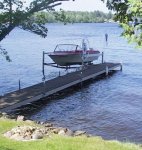Re: Hull gouges
Based on your over all description, I truly believe you will be able to sand them or scrape them out, wash em with acetone and fill them with a Gel Coat paste, then sand and buff them out and you will barely be able to notice them. White GelCoat is NOT always WHITE. You may need to do some blending to get it to match exactly. Just depends on how much of and exact match you desire. But as others have said, Pics would really help us to help you.
This is a more detailed description of how the repair should go
Before you begin, wash the area with soap and water and rinse it thoroughly. If the surface is oxidized, restore it with a rubbing compound so you?ll be able to match its colour accurately. Once the surface is clean and dry, mark off the repair area with masking tape.
Start by sanding the gouges with 80 grit and then finish by lightly sanding with 220-grit sandpaper. After sanding, thoroughly clean the area with acetone to remove the sanding residue and any waxes or other contaminants that might interfere with the bond between the damaged surface and gelcoat. Be sure to provide adequate ventilation and proper protection for your skin and eyes whenever you work with acetone.
The next step is to match the colour of your existing gelcoat. Start with a white or neutral gelcoat paste (not resin) and begin adding tiny amounts of coloring agent. Mix several test batches of gelcoat and pigment, add hardener and allow them to cure (gelcoat changes colour during the curing process). Once you?ve found an acceptable match (an exact one is nearly impossible), mix a final batch using the same ratio.
Next, using a putty knife, fill the areas to be repaired with the paste you?ve mixed. Force out any air holes and
be sure to overfill, as gelcoat has a tendency to shrink as it cures. When you are finished filling,
seal the repair off from the air with a PVA curing agent or a piece of Saran Wrap or wax paper ? gelcoat does not cure properly when exposed to air.
Once the gelcoat has fully cured, sand the repair smooth (wet sanding works particularly well with gelcoat). You can start with 220-grit sandpaper and, for a really slick surface, finish with at least 400- or 600-grit. Finally, apply a coat of high-quality marine polish and your repair is complete.
I'm just sayin...





















